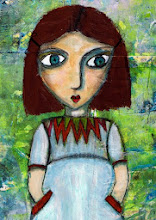 The style of these journals is borrowed from the palm leaf journals found in Asia. There, sheets of paper (papyrus) made from palm leaves are bound on a thong between wooden covers. Most of the palm leaf books I've seen or heard of contain sacred texts. These journals contain blank pages, so the recipients can use them to write and store their own secret or sacred content.
The style of these journals is borrowed from the palm leaf journals found in Asia. There, sheets of paper (papyrus) made from palm leaves are bound on a thong between wooden covers. Most of the palm leaf books I've seen or heard of contain sacred texts. These journals contain blank pages, so the recipients can use them to write and store their own secret or sacred content. For the covers, I started out by cutting two pieces of balsa wood. Anything between 2-4 mm thickness will be fine. You can also use sturdy cardboard or bookbinder's board. These particular covers are 5x15cm (ratio 1:3), to fit in the cartons I'm using for the Art In A Carton project. For my own use, I prefer 5x20cm (ratio 1:4). I drilled two holes in each cover before painting and so on. By drilling the holes at the start of the process, you can save yourself the trouble of having to go back and touch up the holes so the wood doesn't show. Simply paint inside the holes as you go.
I base coated the covers using Pelikan Prism, a two-tone acrylic paint that contains gold pigment. Two books are done in pink/gold and one in blue/gold. I then used a hot glue gun to dribble threads of glue onto the covers. Once cooled, I rubbed alcohol inks in to the threads. After a couple of minutes drying time, I went over parts of the covers with light coats of Lumiere metallics. After the covers were completely dry again, I dabbed on just a hint of glitter glue and a dusting of micro pearls.
 Each journal contains around 10 pages. Just cut card stock to size and use the holes in the covers as a guide to mark out where the holes need to be in the card stock. Punch the holes with an eyelet tool, or whatever you have for the job.
Each journal contains around 10 pages. Just cut card stock to size and use the holes in the covers as a guide to mark out where the holes need to be in the card stock. Punch the holes with an eyelet tool, or whatever you have for the job.Cut 2 lengths of narrow ribbon for each book. (I used 3 mm ribbon, because that's what I had. You might prefer to use twine or leather thongs or, or, or...) Each length or ribbon measures around one metre.
Thread each length of ribbon through one set of holes. Tie a bead or a button at the end of each length or ribbon, to prevent it slipping out of the holes. Repeat for the other set of holes.


1 comment:
These are so unique and beautiful. I really appreciated the explanation of the technique you used. I find it so intriguing.
Post a Comment